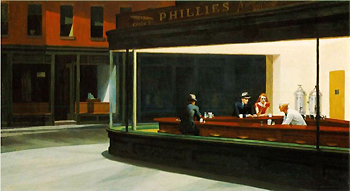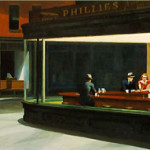By BEN SLOAT
I’ve debated the merits of Edward Hopper over a number of years. Always I’ve thought of him as a Willy Loman figure, an unobtrusive traveler of New York and New England, quietly painting the slow failures of society passing him by, unwilling to shout, to be impolite.
With the large and complete Hopper show at the MFA, a somewhat new figure is cast. Overall, Hopper still embodies the very post-Depression sensibilities of looking at the fabric, the characters, and the landscape of the ordinary, all in the face of the crumbling glamour of the decade preceding.
Despite their respective settings, his figures are often isolated and contemplative. In this regard, what makes his iconic Nighthawks so unusual are the group of strangers coming together in spite of their solitude. It’s his most social of paintings, but one of many with a strong cinematic sensibility. The truly isolated one continues to stand on the sidewalk, looking in at the scene (though the gentleman at the counter with his back turned to us is often thought to be Hopper himself).
There’s a lot to be said in parallels between Hopper’s sensibilities and that of Walker Evans, looking at the vernacular during a very similar time period in America. But where Evans seems focused on unique details (local signs, architecture, people on the street), Hopper looks at general institutions (restaurants, movie theatres, offices). The result is that Hopper’s world is accessible, a shared vision, while Evans’ world is his own.
Where Hopper truly shines through is with his humor, often dark. House By the Railroad shows a stately Victorian home whose ground floor is visually bisected by train tracks. This house, apparently the inspiration for Hitchcock’s Bates Motel, seems to grin with bared teeth. It’s as imposing and impenetrable an institution as Van Gogh’s Church at Auvers.
His most biting work must be Drug Store. Positioned on a street corner at night, light burst forth from the pharmacy onto the sidwalk. Emblazoned in the window are the words “Prescriptions, Drugs, Ex-Lax.” Hopper’s commentary here is reminiscent of Jack Nicholson’s Joker from Tim Burton’s first Batman movie: “this town needs an enema!”
- Edward Hopper, Nightwawks, oil on canvas, 1942, Chicago Institute of Art, Chicago
- Edward Hopper, House by the Railroad, oil on canvas, 1925, Museum of Modern Art, New York City
Museum of Fine Arts, Boston
Wikipedia - Edward Hopper
"Edward Hopper" was on view until August 19th at the Museum of Fine Arts, Boston - located at 465 Huntington Ave.
All images are courtesy of the Museum of Modern Art, Art Institute of Chicago, the Museum of Fine Arts, Boston, and Wikipedia






